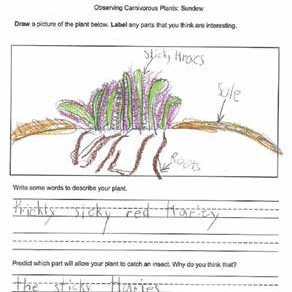
Capturing Insects and Student Interest



Capturing Insects And Student Interest: First graders learn about unusual plants in their area in this multimodal investigation of carnivorous plants.
Download the full article in .pdf.
This is an excerpt of an article from Science and Children, March 2016 by Leslie Bradbury, Rachel Wilson, Nancy Pepper, and Mitzi Ledford. (Use with permission from the authors.)
Most plants are able to obtain all of the nutrients that they need from air, water, and soil; however, this is not true of carnivorous plants. Because they tend to live in boggy soils where there are small amounts of nitrogen, carnivorous plants have developed specialized structures that enable them to lure and capture insects and sometimes other small animals (ICPS 2015). Because Venus flytraps, pitcher plants, and sundews are all native to our state and use different structures to capture their prey, we chose those as our focus (see Internet Resources). Studying the natural world can be fascinating for young learners and can provide an opportunity for teachers to incorporate multiple tools for science communication. In this article, we describe an integrated, multimodal unit around the theme of carnivorous plants (CPs) for two first-grade classrooms. For our unit, we focused on plants with three different structures and trapping mechanisms (see Table 1, p. 45). The distinctive structures visible on the plants provided an opportunity to help students understand the link between the structure of a particular plant part and its function in survival, while also providing students the opportunity to engage in the science practices of Analyzing and Interpreting Data, and Obtaining, Evaluating, and Communicating Information (NGSS Lead States 2013).
Conclusion: Due to our experiences with the students’ enthusiasm for and knowledge growth in CP parts and their function for luring and capturing prey, we believe that CPs offer an exciting context for preparing students to think creatively about adaptations that help organisms survive. After completing this unit on CPs, students are on their way to having the foundational knowledge to meet the performance expectations included in the Next Generation Science Standards (NGSS ) in which they must “use materials to design a solution to a human problem by mimicking how plants or animals use their external parts to help them survive, grow, and meet their needs” (NGSS Lead States 2013, p. 12).
